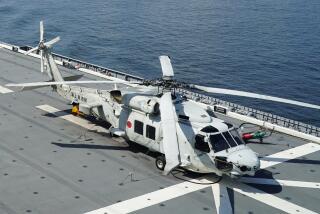SEALs killed in Afghan crash were answering call for help
- Share via
Reporting from Kabul, Afghanistan — The military helicopter that crashed killing 30 U.S. service members Saturday went down as it was arriving to reinforce beleaguered fellow troops engaged in fierce fighting, according to new details released by Western military officials.
The twin-rotor Chinook helicopter, carrying members of the elite commando SEALs as well as seven Afghan commandos and other U.S. troops, was downed as it arrived at the scene of a battle with insurgents after another force called for help, the NATO mission in Afghanistan said in a statement Monday. That second force has been identified by military sources as U.S. Army Rangers, who work closely with the SEALs.
Some Western and Afghan officials originally said the chopper went down while lifting off after an engagement with insurgents in a restive district of Wardak province. A precise chronology of the raid that resulted in the largest loss of military lives in the course of the 10-year Afghan conflict has been slow to coalesce, in part because of the intense operational secrecy associated with the elite units involved.
Monday’s NATO statement was the first detailed public accounting of the incident, describing an operation that “began as a security search for a Taliban leader responsible for insurgent operations in the nearby Tangi Valley.” The area, a gateway to the capital, Kabul, has been overrun by Taliban and other insurgent groups in recent months.
Special-operations troops carry out hundreds of raids a month across Afghanistan, based on intelligence-gathering and primarily targeting insurgent field operatives. Most of the raids take place at night.
The urgent nature of the SEALs’ fatal raid — a hastily assembled mission — probably accounts for the fact that so many were rapidly deployed aboard a large, relatively slow-moving Chinook, a workhorse of the U.S. aviation fleet in Afghanistan used to transport troops and insert them into action. When staging a raid at the time and place of their choosing, clandestine forces normally travel aboard smaller, nimbler aircraft, and in less sizable groups.
In Saturday’s firefight, the initial team on the ground spotted insurgents armed with rocket-propelled grenades in the area and engaged them, calling around the same time for help, the NATO force said.
“These additional personnel were inbound to the scene when the CH-47 carrying them crashed, killing all on board,” the statement said, adding that the troops already on the ground — backed by forces from a nearby Western base — then moved in to secure the scene. No casualties were reported among them.
The statement identified those aboard as five air crew members and 25 personnel from the Special Operations command. Previous reports have said those attached to the SEALs force included a civilian interpreter and a dog handler.
Western officials, meanwhile, said the incident should not be depicted as a larger barometer of battlefield fortunes.
“The incident, tragic as it was … will have no influence on the conduct of operations,” said Brig. Gen. Carsten Jacobson, a German spokesman for the North Atlantic Treaty Organization force.
Even in the absence of hostile fire, helicopters are vulnerable to mechanical problems and bad weather. Early Monday, a U.S. helicopter made a “hard landing” — essentially a controlled crash — in Paktia province, near the Pakistan border.
Western officials said that there was no indication of hostile fire, and that the special-operations forces who were awaiting pickup then secured the area and attended to the crew.
More to Read
Sign up for Essential California
The most important California stories and recommendations in your inbox every morning.
You may occasionally receive promotional content from the Los Angeles Times.










